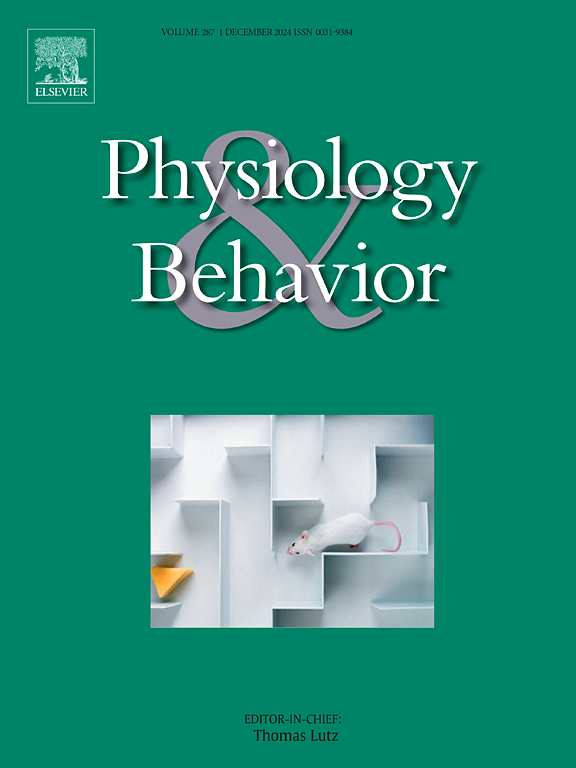Female mantled howler monkeys (Alouatta palliata mexicana) alter their diet in terms of tannin consumption according to their reproductive stage
IF 2.5
3区 医学
Q2 BEHAVIORAL SCIENCES
引用次数: 0
Abstract
Tannins (TN) are polyphenolic compounds primarily known to be involved in the defense mechanism of vascular plants against herbivory. Their excessive consumption can cause damage to an animal's digestive tract; yet, with moderate consumption, tannins have several beneficial health effects that have been well studied. However, little attention has been paid to the specific benefits of tannins for female health in different species. In this study, we investigated the role of TN content in the diet of female howler monkeys (Alouatta palliata mexicana) at different reproductive stages. From September 2021 to August 2023, we monitored a group of free-ranging mantled howler monkeys on Agaltepec island, Catemaco, Mexico. We recorded the feeding behavior of 20 adult females during different reproductive stages (cycling, gestating, and lactating stage). In 670 contact hours, a total of 1474 feeding sessions were recorded along with the collection of 31 different plant parts from 13 different vegetative species for subsequent tannin evaluation. Results showed that tannin intake significantly increased during lactation in comparison to the cycling stage. However, the increase in tannin intake was primarily due to high flower consumption. Fruit consumption did not affect dietary tannin levels. There were no significant changes in overall food consumption between reproductive stages. Our findings indicate that increased tannin consumption may play an important role for female howler monkeys during reproduction. However, the nature of the role is yet to be identified.
雌性毛吼猴(Alouatta palliata mexicana)根据其生殖阶段改变其饮食中的单宁消耗。
单宁(Tannins, TN)是一种多酚类化合物,主要参与维管植物对草食的防御机制。它们的过量食用会对动物的消化道造成损害;然而,适量饮用,单宁有几个有益健康的影响,已经得到了很好的研究。然而,很少有人关注不同种类的单宁对女性健康的具体益处。本研究研究了不同生殖阶段雌性吼猴(Alouatta palliata mexicana)饮食中TN含量的作用。从2021年9月到2023年8月,我们在墨西哥卡特马科的阿加尔特佩克岛监测了一群自由放养的披毛吼猴。我们记录了20只雌性成虫在不同生殖阶段(循环期、妊娠期和哺乳期)的摄食行为。在670个接触小时内,共记录了1474次取食,并收集了13种不同植物的31个不同部位,用于随后的单宁评价。结果表明,与循环阶段相比,哺乳期单宁摄入量显著增加。然而,单宁摄入量的增加主要是由于花的大量消耗。食用水果不会影响饮食中的单宁含量。在繁殖阶段之间总的食物消耗量没有显著变化。我们的研究结果表明,单宁消耗的增加可能在雌性吼猴繁殖过程中起重要作用。然而,这一角色的性质尚未确定。
本文章由计算机程序翻译,如有差异,请以英文原文为准。
求助全文
约1分钟内获得全文
求助全文
来源期刊

Physiology & Behavior
医学-行为科学
CiteScore
5.70
自引率
3.40%
发文量
274
审稿时长
47 days
期刊介绍:
Physiology & Behavior is aimed at the causal physiological mechanisms of behavior and its modulation by environmental factors. The journal invites original reports in the broad area of behavioral and cognitive neuroscience, in which at least one variable is physiological and the primary emphasis and theoretical context are behavioral. The range of subjects includes behavioral neuroendocrinology, psychoneuroimmunology, learning and memory, ingestion, social behavior, and studies related to the mechanisms of psychopathology. Contemporary reviews and theoretical articles are welcomed and the Editors invite such proposals from interested authors.
 求助内容:
求助内容: 应助结果提醒方式:
应助结果提醒方式:


